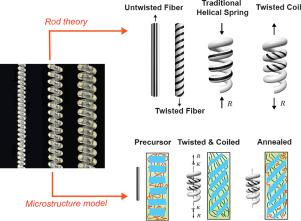当前位置:
X-MOL 学术
›
Int. J. Mech. Sci.
›
论文详情
Our official English website, www.x-mol.net, welcomes your feedback! (Note: you will need to create a separate account there.)
The mechanics and physics of twisted and coiled polymer actuators
International Journal of Mechanical Sciences ( IF 7.1 ) Pub Date : 2024-07-02 , DOI: 10.1016/j.ijmecsci.2024.109440 Qiong Wang , Anan Ghrayeb , SeongHyeon Kim , Liuyang Cheng , Sameh Tawfick
International Journal of Mechanical Sciences ( IF 7.1 ) Pub Date : 2024-07-02 , DOI: 10.1016/j.ijmecsci.2024.109440 Qiong Wang , Anan Ghrayeb , SeongHyeon Kim , Liuyang Cheng , Sameh Tawfick

|
Twisted and coiled polymer actuators (TCPAs) generate large contractile mechanical work mimicking natural muscles, which makes them suitable for robotics and health-assistive devices. Understanding the mechanism of nylon TCPA remains challenging due to the interplay between their intricate geometry, chirality, residual stresses, and material microstructure. This study integrates a material microstructure model with rod theory to analytically predict the equilibrium helical shape of the nylon TCPA after fabrication and to explain the observed contraction mechanism upon stimulation. The first ingredient of the model is to treat nylon as a two-phase thermomechanical microstructure system capable of storing strain energy and exchanging it between the two phases. This is validated by characterizing the torsional actuation response of twisted and annealed nylon fibers. The second ingredient of the model is to use the classic Kirchhoff Rod Theory and add a necessary term that couples the bending and twisting energy to enable the equilibrium between the two phases, which are arranged as springs in parallel. Validation with experiments shows that the model captures the equilibrium and longitudinal stiffness of the TCPA at rest, in the active, and in the passive states, as well as the stimulated contraction under external load. Importantly, the model quantifies the influence of the stored energy level on the actuation performance. These concepts can be extended to other types of TCPAs and could enable new material design.
中文翻译:

扭曲和卷曲聚合物致动器的力学和物理
扭曲和卷曲聚合物执行器 (TCPA) 产生模仿自然肌肉的大量收缩机械功,这使得它们适用于机器人和健康辅助设备。由于尼龙 TCPA 复杂的几何形状、手性、残余应力和材料微观结构之间的相互作用,了解尼龙 TCPA 的机理仍然具有挑战性。本研究将材料微观结构模型与杆理论相结合,以分析方式预测尼龙 TCPA 制造后的平衡螺旋形状,并解释观察到的刺激时的收缩机制。该模型的第一个要素是将尼龙视为能够存储应变能并在两相之间交换应变能的两相热机械微观结构系统。通过表征加捻和退火尼龙纤维的扭转驱动响应来验证这一点。该模型的第二个要素是使用经典的基尔霍夫杆理论,并添加一个必要的项来耦合弯曲和扭转能量,以实现平行排列的弹簧两相之间的平衡。实验验证表明,该模型捕获了 TCPA 在静止、主动和被动状态下的平衡和纵向刚度,以及外部载荷下的刺激收缩。重要的是,该模型量化了存储能量水平对驱动性能的影响。这些概念可以扩展到其他类型的 TCPA,并可以实现新的材料设计。
更新日期:2024-07-02
中文翻译:

扭曲和卷曲聚合物致动器的力学和物理
扭曲和卷曲聚合物执行器 (TCPA) 产生模仿自然肌肉的大量收缩机械功,这使得它们适用于机器人和健康辅助设备。由于尼龙 TCPA 复杂的几何形状、手性、残余应力和材料微观结构之间的相互作用,了解尼龙 TCPA 的机理仍然具有挑战性。本研究将材料微观结构模型与杆理论相结合,以分析方式预测尼龙 TCPA 制造后的平衡螺旋形状,并解释观察到的刺激时的收缩机制。该模型的第一个要素是将尼龙视为能够存储应变能并在两相之间交换应变能的两相热机械微观结构系统。通过表征加捻和退火尼龙纤维的扭转驱动响应来验证这一点。该模型的第二个要素是使用经典的基尔霍夫杆理论,并添加一个必要的项来耦合弯曲和扭转能量,以实现平行排列的弹簧两相之间的平衡。实验验证表明,该模型捕获了 TCPA 在静止、主动和被动状态下的平衡和纵向刚度,以及外部载荷下的刺激收缩。重要的是,该模型量化了存储能量水平对驱动性能的影响。这些概念可以扩展到其他类型的 TCPA,并可以实现新的材料设计。












































 京公网安备 11010802027423号
京公网安备 11010802027423号